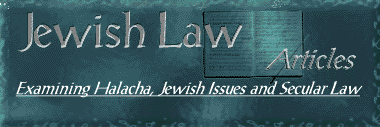

Rabbi Michael J. Broyde & Rabbi Michael Hecht
IX. How Does the Finder Identify the Owner?
According to both Jewish and common law, there is an obligation to return the item to the original owner, and to make an effort to find that original owner.100 However, how does a finder determine if the person who is claiming the article actually is the true owner, and not a person who lost a similar item and mistakenly thinks this item is his, or a thief trying to claim an item which is not really his? This dilemma is particularly problematic, since both Jewish and common law make a finder strictly liable if he returns the item to the wrong person and the true owner subsequently claims the item.101 Jewish law addressed this issue at great length, while the common law left this as a matter of fact to be determined in each individual case, (although the legal principles used by both systems are similar).
According to Jewish law one must return lost property to a person who provides witnesses that the item is his, or recounts unique characteristics of the item so as to make it highly likely that the item is his.102 Whether the requirement that the finder return the object to one who furnishes indicia of true ownership is of Biblical origin or a later enactment of the Rabbis is the subject of an extensive Talmudic discussion.103 The Talmud offers a practical reason to explain the opinion which views these marks (simanim) as a pragmatic Rabbinic institution, a possibility that a thief might be able to furnish adequate simanim is clearly outweighed by the possibility that the rightful owner would be foreclosed from pursuing his property for lack of witnesses.104 Early authorities attempt to resolve this dispute by distinguishing between three different kinds of signs or symbols.105 First, striking, distinguishing characteristics ordinarily not found in such an object are efficacious to establish ownership, a universally accepted fact and on a biblical level.106 The classic Talmudic example is the identification of a lost document by furnishing the information that a hole may be found next to a particular letter. It is nearly universally accepted that such marking are efficacious to establish facts even on a biblical level. The Talmudic controversy as to whether such marks are a rabbinic institution or of biblical origin bears on the second level, uncommon marks. This category embraces such factors as exact size, weight, number, and location of find.107 These types of marks are common to many items, but it is unlikely that anyone but the owner would know them for a particular object. The third category, minimal marks, comprises those identifying characteristics which are not sufficiently unique to be accorded reliability, e.g., a general description of size or color such as large, small, red, etc.108
Jewish law generally accepts that one returns lost property to an honorable person if that person presents marks of the middle category -- uncommon marks.109 The Sages added an additional condition to this rule: one should not return an object to an unknown person until that person presents some proof that he is an honorable person, and not a thief.110
The common law presented a similar type of legal rule, albeit without the detailed developments found in Jewish law. When the true owner discovered his object, and the finder refused to return the object, the owner would follow the civil procedure of that particular locale for reclaiming one's property in the possession of another. In common law of old, typically that was either trover or replevin, and if the finder claimed title, conversion.111 Unlike Jewish law, common law and New York law treated the return of lost property no differently than any other civil case between two claimants, with one party claiming ownership of an item in the possession of another. There are hardly any cases which discuss how one goes about proving that one is the original owner of lost property; that presumably was the province of a jury or judge determination. For example, a recent New York case involved a true owner suing a finder of airplane tools who had mistakenly given the tools to a third party who claimed to be the owner (but wasn't as determined by the court). The court ruled that:
At common law, a finder was entitled to the use, possession, and enjoyment of any property he had found as against the whole world, except for the true owner. It also followed, at common law, that a finder was not liable, civilly or criminally, for keeping the property he had found against all false claims of ownership, or even against claims of ownership which the finder reasonably believed to be false. Yet, at common law, if a possessor of goods, such as a finder, delivered property to a third person whom he reasonably believed to be the true owner--but was mistaken as to that fact--he became liable to claims by the true owner, notwithstanding his delivery of the found property to a third person by honest mistake.112
In the current New York statute there is no discussion of the remedy available to an owner whose item is returned to the wrong person by the police. Certainly the finder is not liable. There simply is no case law on the liability of the police for improperly returning items to someone other than the owner.
Thus, while Jewish law has a much more legally detailed system, the basic rules used by Jewish and common law remain the same in this area.
1 | 2 | 3 | 4 | 5 | 6 | 7 | 8 | 9 | 10 | 11 | 12 | 13 | Notes

DISCLAIMER
|
|
Page 9 of 13 |
|